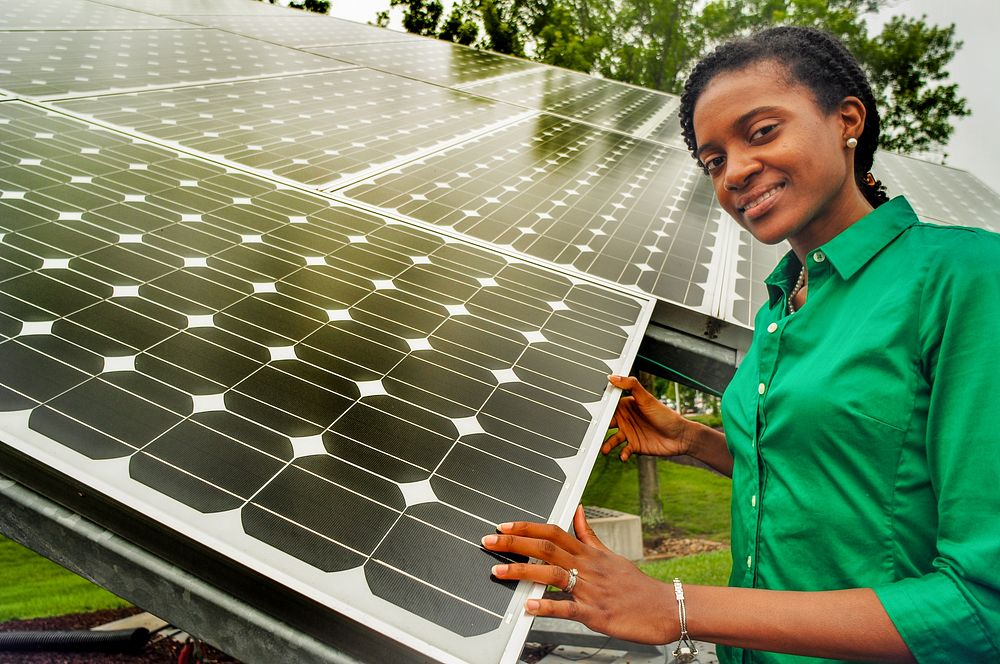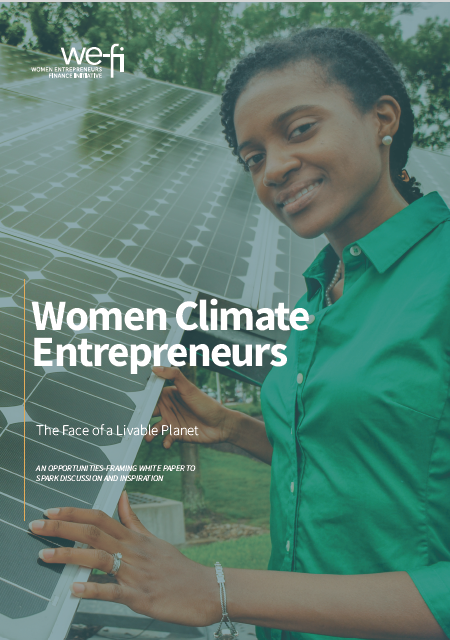A growing number of funders work in the climate sector to support women. That’s the good news. Because women are disproportionately vulnerable to climate-related disasters, incorporating gender into aid to slow or stop the climate crisis helps the most vulnerable people.
Yet, recent research from We-Fi found that, as funders work to build the new green/blue economy, too few engage with women as leaders or entrepreneurs. We’re releasing the findings in a white paper, Women Climate Entrepreneurs: The Face of a Livable Planet.
Only 1% of development assistance by governments incorporates gender as a primary objective. The funders that are acting at the nexus of climate and gender tend to be small and do not provide sufficient financing.
Funders are missing opportunities. As leaders in their households and communities, women often have the ability to recognize and enact solutions related to climate change. In particular, women entrepreneurs have unique insights into business models that increase efficiency or solve environmental problems at scale. In short, women have the most at stake and much to offer when it comes to climate solutions and innovations for the world.
”Women entrepreneurs have unique insights into business models that increase efficiency or solve environmental problems at scale.
Many women entrepreneurs in We-Fi’s funding portfolio and beyond are already working on climate-crisis solutions. We’ve included some of their stories in the report. But barriers to entry remain high in traditionally male-dominated sectors like manufacturing, where women might make an enormous difference.
At a recent We-Fi webinar on climate finance, panelists focused on initiatives to reframe the way women are seen in the context of the climate crisis. Panelists included Jamille Bigio, Senior Coordinator for Gender Equality & Women’s Empowerment at USAID, Elisabeth Maier, Senior Operations Officer at RENEW MENA (World Bank), Nina Kolybashkina, Senior Social Development Specialist at The Climate Investment Funds (CIF) and Jimena Serrano, Gender, Diversity and Finance Lead at IDB Invest.
“We are trying to … to raise the bar, to talk beyond women as being victims who are disproportionately affected,” said Kolybashkina. Instead, she said: “Women are the drivers. Women are the leaders.”
A Survey of Climate Finance for Women
Official donor assistance (ODA) for climate has increased in recent years, from $26.9 billion in the year 2014–2015 to $33.1 billion in the year 2018–2019. But the amount of climate aid dedicated to gender as a primary objective stood at only $778 million in 2018–2019, representing just 2.4 percent of climate-focused donor aid, according to data from the OECD Development Assistance Committee.
Yet, there has been progress. Donor funding for climate initiatives that included a gender component increased, from $9.6 billion in 2014–2015 to $18.9 billion in 2018–2019.
The We-Fi team performed a desktop review of funders working at the nexus of climate and gender. Of the 53 funders the researchers examined, 19 funders, tending to be the largest by fund size, emphasize climate with gender as a secondary consideration. Eleven focus on gender as a primary objective. Twenty-three funders emphasize gender and climate, but they tended to be small, and not provide finance. (You can find a list of funders in the annex at the paper’s end).
Opportunities Ahead
The paper also looked at the opportunities for women’s entrepreneurship in specific sectors. Researchers found three key areas where women already have a strong presence: Energy systems and last-mile interventions; the circular economy; and food systems. For instance, women hold 40% of the jobs in solar businesses.
Other areas of opportunity include carbon capture and storage, sustainable transportation, manufacturing and environmental engineering. In these male-dominated sectors, the barriers for women are high, and so are the opportunities for new innovations and higher profits – precisely because what women bring to the table will be different.
The paper also discussed financial vehicles that show promise for expanding the funds available for women climate entrepreneurs from the private sector, including venture capital, blended finance, gender and climate bonds, and results-based instruments, such as social impact bonds.
No One Left Behind
Climate action is driving new funds, but only some of them are reaching women entrepreneurs. That’s because the finance system isn’t changing fast enough. Funders need to have a mandate to act at the nexus of gender and climate. Without that mandate, leaders in the aid community could overlook the opportunities for change embodied in entrepreneurial women.
In Latin America and the Caribbean, the transition to a green/blue economy is expected to bring 15 million new jobs. “They’re mostly going to be created in what we know today as male-dominated industries,” said Jimena Serrano at the webinar. “So, if we don’t do anything, we will continue as we are, with the exclusions that we are experiencing now.”
“We want a just transition, where nobody is left behind, where the solutions are responsive to the needs of everybody, women, men and all the vulnerable populations.”
Download the white paper to learn more and watch the webinar here.
__________________________________________________


